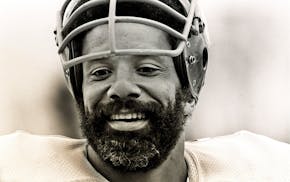MANKATO – Four former Vikings are among the 111 deceased NFL players whose brains were studied by researchers from Boston University and the VA Boston Healthcare System as part of the report published Tuesday in the Journal of the American Medical Association.
The three whose names were made available to publish were Wally Hilgenberg, who played linebacker for the Vikings from 1968-79; Gerry Huth, who played guard from 1961-63; and Grant Feasel, a center from 1984-86. According to a spokesperson representing the study, the release of the fourth name has been embargoed until 10 a.m. Thursday.
The study included 202 former football players at the high school, college, semiprofessional and professional levels. Of those 202, 177 were found to have the brain disease chronic traumatic encephalopathy, or CTE, which can cause a wide range of neurocognitive problems. Among the 111 NFL players, CTE was discovered in all but one.
The study also noted that 93 percent of the 177 players with CTE had donated their brains to the study because they had shown cognitive trouble before their deaths.
The study came out as current NFL players were opening training camps. Although there are league-mandated safeguards now in place to try to reduce head trauma caused by concussions and repetitive hits to the head, studies like this do catch the attention of today's players.
"I probably haven't spent a ton of time looking at the numbers and the studies, but I think it's starting to become a little bit more concerning because it seems that each study that comes out, they're finding more and more brain trauma, which is obviously a little bit scary," Vikings quarterback Sam Bradford said Wednesday. "But, at the same time, I don't think you can pay attention to it because if you start looking at all those and get worried, it takes away from your ability to go out there and actually play football.
"I think it comes with the understanding that these are the risks we take when we play football."
Guard Joe Berger, a 13-year veteran who missed games because of a concussion late last season, said he doesn't pay much attention to the studies. He also said he'd like to see more study numbers involving former players who don't experience CTE-related symptoms.
"There are lots of things that can happen to you in life," Berger said. "Obviously, you're raising your chances by playing football. But, no, I'm not too concerned about it."
Scott Studwell, who's now a college scout for the Vikings, played middle linebacker for 14 seasons (1977-90). His 1,981 career tackles are a team record. Speaking in general about concussions before Tuesday's report was published, Studwell said he's never experienced any cognitive problems and would play his career all over again if given the chance.
Mary Hilgenberg, Wally's widow, and her family took a much different stance toward the game. They became outspoken critics of football as Wally, who played 16 NFL seasons total, developed Lou Gehrig's disease, died in 2008 and became the fifth former NFL player to donate his brain to the Center for the Study of Traumatic Encephalopathy at Boston University. Those doctors determined that Hilgenberg died because of CTE caused by repeated head trauma from playing football.
"We have four kids and 22 grandchildren, and the grandchildren aren't allowed to play football," Mary Hilgenberg said. "One grandchild, Luke, walked away from the game as a freshman at Iowa a few years ago.
"Head trauma in football is such a serious, serious problem. But if you speak against football, it's like speaking against somebody's religion. But how can parents today allow their children to play football? They strap them in a seat belt, but then they drive them to a football field? It doesn't make any sense to me."

The PWHL's growth comes with a price for a Minnesota Frost team building a potential dynasty.
What is the 'House settlement,' and what does it mean for the Gophers and NCAA?

Souhan: Anxiety and depression in the NFL helped inspire Lindsey Young's children's book

Reusse: Country boy Jim Marshall never lost his lust for life

